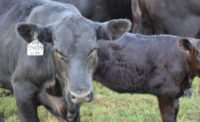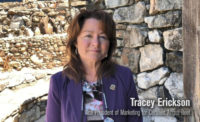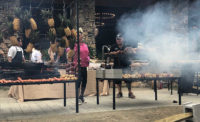Many educational seminars feature expert speakers, quizzes and field trips. Fewer include a breakdown of a beef carcass, and fewer still involve a cooking competition involving those same muscles that were discussed in that breakdown. Those professionals who attend the Associate’s in Meat program at the Certified Angus Beef Culinary Center in Wooster, Ohio received a wide-ranging education in beef over the course of a week.
CAB has run a Master’s of Brand Advantage (MBA) program for eight years, but that course is a three-week program. This Associate’s class offers a one-week focus on cut identification and sales skills. The first program, from July 30-August 1, was attended primarily by foodservice distributors. Brett Erickson, director of value-added products at CAB, said that the attendees wanted to be able to speak to their foodservice clientele in a more knowledgeable manner.
“We found that salespeople want to become more knowledgeable, to get their hands on the product, to understand where each of these cuts come from and the value of those cuts,” he explained. “They want to be able to talk to the chefs intelligently and say ‘I've seen this cut, I know where it comes from, and I know the value it can bring to you and your guests.’”
Erickson said that the added understanding creates a point of differentiation between the educated salesperson, who wants to be a problem solver, and the salesperson who just wants to be an order-taker.
The Associate’s program was held at the CAB Culinary Center, which houses a fabrication room, a professional, fully stocked kitchen, additional preparation areas and gathering spaces. Attendees got a farm-to-fork education, including an explanation of what makes Certified Angus Beef different than other beef programs. They toured nearby Atterholt Farms to see the production side of the industry and watched a packing plant video to learn about the processing industry.
The highlights of the course included time spent in the CAB fabrication room, where meat scientist Diana Clark broke down a cattle carcass to show exactly where each cut can be found. Her demonstrations of the chuck/brisket, loin and rib/plate cuts included not only the familiar T-bone and New York Strip but also underutilized cuts like the Denver steak and sirloin flap. These demonstrations were interactive. Once Clark had shown the attendees where these cuts are located, they broke into teams and were given the chance to break down their own carcasses.
Between demonstrations, the attendees had an opportunity to put their education to practical use with a cooking contest. Again in teams, they had to prepare one of five steaks (strip loin, top sirloin, ranch steak, Denver steak, Sirloin flap), seasoned and cooked however they wanted. The steaks were graded on presentation and taste, with a degree of difficulty associated with each of the five cuts. Many of the attendees came from culinary backgrounds, so while there could only be one winner (a thyme and pepper-seasoned sirloin flap), all of the groups prepared menu-worthy steaks.
The majority of the attendees were from broadline and independent foodservice distributors, but there were some processors in attendance as well. Erickson says that the processors should be as knowledgeable about their products as the distributors.
“Any company that's committed to selling Certified Angus Beef has to be knowledgeable enough to communicate it to the next tier in the system. Otherwise, somewhere that message of what the brand is all about is lost,” he explained. “That's why we spend so much time in training, because we feel education is the key to being able to help communicate the difference between the Certified Angus Beef brand and other Angus programs, other quality grades of beef. If they don't understand that, then they will not be effective in selling this product to the customer.”













Report Abusive Comment